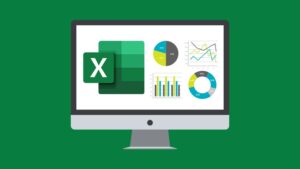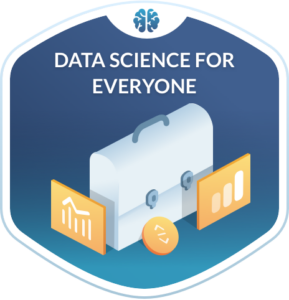Best Data Analytics Courses - Q2 2023
Our Expert Picks

Time to Complete:
# Enrolled:
Content Coverage:

Lecturer Quality:

Quiz Quality:

Exercise Quality:

Our Expert Review
Content Coverage (5/5)
This course covers eight weeks of material with one module per week. Each module is comprised of several in-depth lessons that include video lectures, readings, discussions, assignments, and quizzes. The material is thoroughly covered with introductions to each concept, real-world examples, and guest lectures. The course is logically sequenced to help learners build upon their knowledge.
The course covers most topics we consider to be essential for a course on Data Analytics. Since the course is focused on data analytics for accounting, tools such as Excel and Tableau are the focus.
Missing Essential Topics:
- R, Python, and Power BI
Lecture Quality (5/5)
The lectures offer a lot of applicable examples that can translate to the learner’s possible career prospects. The main lecturer is a professor at the University of Illinois School of Accountancy. The guest lecturers include a programmer at the university and the Director of Application and Analytics for an NFL team.
The lectures are about seven minutes long and include useful graphics and visuals. There are at least ten lectures per week.
Quiz Quality (5/5)
There are about three to four quizzes per week containing multiple-choice, true/false, and fill-in-the-blank questions. Most lessons contain one practice quiz and the module’s conclusion includes a graded quiz. The practice quizzes help learners assess their knowledge without a grade. The graded quizzes are for credit. The score for the graded quizzes is used in calculating the final score for the class.
All quizzes are automatically scored upon submission and learners are provided with helpful feedback for questions answered incorrectly. Learners can take the graded quizzes three times every eight hours and only the highest score is used in the calculation of the final score. Quizzes are graded automatically upon submission.
Assignment/Exercise Quality (4/5)
There are two peer-reviewed assignments at the end of weeks 4 and 6. The first project is creating a visualization from given data and the second project is writing a report based on data visualization.
Learners are also expected to review assignments submitted by their peers. This can be an excellent learning tool for conscientious learners. However, neither the learner submissions or peer reviews are supervised by an instructor.
Certificate Brand Quality (5/5)
The course is part of a partnership between Coursera and the University of Illinois. The course is offered as part of a certificate called Accounting Data Analytics Specialization. This course is also part of a master’s program.

Time to Complete:
# Enrolled:
Content Coverage:

Lecturer Quality:

Quiz Quality:

Exercise Quality:

Our Expert Review
Content Coverage (5/5)
This course was specifically designed for intermediate to advanced Excel learning for Data and Business Analysts. The course is delivered using version 2016 and Office 365. However, learners using 2007, 2010, 2013, 2016 and 2019 have the same compatibility as shown in the instructional videos.
A total of 57 sections containing 253 lectures, practice exercises and quizzes will require a total of 33 hours of committed time. The topics presented are intermediate to advance in nature and contain the majority of topics we consider essential.
Lecture Quality (5/5)
The lecture videos are extremely professional and easy to follow. A Udemy presenter introduces the section and prepares the learner for what to expect in the section.
A transcript is available for each lecture on the right pane of the video as well as captioning for the hearing impaired. Captions are available in English only.
Quiz Quality (5/5)
Quizzes comprised of multiple-choice questions are offered at the end of each section and directly after an exercise. The learner can see if their answer is correct or incorrect prior to moving on to the next question. The consistent use of quizzing allows learners to reinforce what they’ve learned before moving on to more complex concepts.
Assignment/Exercise Quality (5/5)
The downloadable resources are well-designed and correspond directly to the information being presented in the lecture, and some contain formulas to get the learner started. The goal is for the learner to practice along with the video and see if they come to the same result as the instructor – an excellent teaching practice.
Certificate Brand Quality (3.5/5)
The Microsoft Excel Data Analysis Toolkit Bundle is instructed by Deborah Ashby of Simon Sez IT, a partner of Udemy. Simon Sez IT has hosted courses for over 640,000 learners, with 95,000 views worldwide. Simon Sez IT learners are comprised of individuals, small businesses, and Fortune 500 companies.
The course offers a certification of completion after all lectures have been reviewed, which is critical given the learning is job specific for Data and Business analysts.

Time to Complete:
# Enrolled:
Content Coverage:

Lecturer Quality:

Quiz Quality:

Exercise Quality:

Our Expert Review
Content Coverage (4/5)
Prepare Data for Exploration covers the areas of gathering/collecting, organizing, and understanding data. It is the third offering in obtaining the Google Data Analytics Certificate. The course is broken into five weeks and there are about four to five short sections each week. Along with the sections per week, there are readings, quizzes, and short assignments.
Most topics we consider to be essential in a Data Analytics course are covered. However, there are some essential topics missing.
Essential Topics Missing
- Big Data
- Building and working with pivot tables
- Data visualization
- Data storytelling
- Python, R, Tableau, and Power BI
Extra Topics Covered:
- Data Ethics
- Data Privacy
- Metadata
- Security and spreadsheets
Lecture Quality (5/5)
The lecturers are engaging, personable, and include many examples and infographics. The lecturers work at Google in data analytics and ethics, so are extremely qualified to teach this Google-backed course. Most lectures are less than 5 minutes in length.
The video lectures also include “pop-up” questions that test the learner’s understanding of the material covered in the lecture.
Quiz Quality (5/5)
This course includes both section and module level quizzes that contain multiple-choice, true/false, and fill-in-the-blank questions. Quizzes within each section are very short, including three to four questions. However, the quizzes at the very end of each section are longer. They are eight to ten questions. The questions accurately cover the topics in each section.
The learner must score 80% before moving on in the course. Quizzes are automatically graded upon submission and learners are presented with immediate feedback.
Assignment/Exercise Quality (4.5/5)
This course has at least two assignments per section. The assignments are not graded, but they are exploratory and help the learner become more acquainted with various tools. Assignments include introducing analyzing data in Excel, exploring Kaggle, and using simple coding concepts.
Certificate Brand Quality (5/5)
The course is provided by Google on the Coursera platform. Google is one of the largest and most respected technology companies in the world and Coursera is a leading online learning platform.

Time to Complete:
# Enrolled:
Content Coverage:

Lecturer Quality:

Quiz Quality:

Exercise Quality:

Our Expert Review
Content Coverage (4/5)
This is an introductory course on the concept of Data Science, so does not go as in-depth in some technical concepts as other courses on our list. Nevertheless, the course provides an excellent overview of the discipline and covers most topics we consider to be essential.
Essential Topics Missing
- Data warehouses
- Building and working with pivot tables
- Programming languages such as SQL, R, Python
- Software packages such as Excel, Tableau, or Power BI
Lecture Quality (5/5)
The video lectures are very well written and include examples, conceptual graphics, slides and animations to better explain concepts to learners. The lectures are brief, focused and logically sequenced.
Quiz Quality (5/5)
There are frequent quizzes and interactive assignments throughout this course. The quizzes tend to be brief and focused multiple-choice questions. Upon submission, the learner is provided with an automatic score and helpful feedback.
Assignment/Exercise Quality (5/5)
Datacamp is known for its use of interactive assignments and this course is no exception. Throughout the course, well designed assignments require the learner to apply what they’ve learned in complex scenarios. These assignments are automatically graded, and feedback is provided upon submission.
Certificate Brand Quality (3/5)
This course is taught by three well-qualified instructors employed by Datacamp. Datacamp is a well-known learning platform, but the brand may not have as much of an impact as ohters on our list.

Time to Complete:
# Enrolled:
Content Coverage:

Lecturer Quality:

Quiz Quality:

Exercise Quality:

Our Expert Review
Content Coverage (4/5)
This course is a short four-week course for beginners covering the basics of Excel for data analytics. There are six to seven lessons per week, with a short quiz after each lesson. In addition, at the end of each week, there is a longer quiz. The course is organized logically, with each lesson building on the next.
Essential Topics Missing:
- Tools and languages such as R, SQL, Tableau and Power BI
- Data warehouses, big data and databases
Extras Topics Covered:
- Some advanced Excel functions
Lecture Quality (5/5)
The instructor is a faculty member at the Jones Graduate School of Business at Rice University. The video lectures are no more than seven minutes and gently introduce and explain the topics to the learner. The videos provide clear examples and tutorials. Learners can also view sample Excel spreadsheets that the instructor references in the lecture.
Quiz Quality (5/5)
The quizzes within the lessons are two questions long, while the end-of-week quizzes are seven to ten questions. The quizzes are easy and help the student reinforce what they have learned in the lessons. The weekly quizzes are more difficult. The quizzes can contain multiple-choice, true or false, multiple-select, and answering questions about spreadsheet images. Depending on the quiz, the learner must pass the quiz with either 80% or 100% to receive credit. Learners can retake quizzes as much as they like.
Assignment/Exercise Quality (1/5)
There are no assignments or exercises available in this course.
Certificate Brand Quality (5/5)
The certificate is offered as a joint partnership between Rice University and Coursera. This course is the first course as part of the Business Statistics and Analysis Specialization.
What to Look For in a Data Analytics Course
Our experts consider the following topics to be essential in a Data Analytics Course.
-
Understanding data
-
Structured vs unstructured data
-
Data sources
-
Big Data
-
Databases
-
Data warehouses
-
Understanding data fields, values, variables
-
Transforming variables
-
Data wrangling/cleaning
-
Understanding datasets
-
Working with pivot tables
-
Descriptive vs prescriptive analytics
-
Data visualization
-
Data and storytelling – skills in conveying data into actionable insights and decisions
-
Basic understanding of programming languages such as Python, R, SQL
-
Basic understanding of software packages such as Excel, Tableau, Power BI
High Growth Jobs in Data Analytics
Click any of the links below to view the salary, job growth, necessary skills, and other information related to these jobs:
The Major Online Learning Platforms
Each online learning platform is unique. Some specialize in certain types of content, some partner with major universities or corporations to develop content, and some have special learning features. While not exhaustive, the list below includes the major online platforms whose courses we feature.
Pros / Cons
Pros: Certificates often are offered from major universities or corporations.
Cons: The quality of course content and features available varies dramatically between courses.
Cost
$$$
Pros / Cons
Pros: Courses are very similar to those offered in colleges.
Cons: The quality of content and features offered varies dramatically between learning programs.
Cost
$$$$
Pros / Cons
Pros: A focus on microlearning with consistently high-quality content. Consistent use of quizzes throughout all courses.
Cons: Pricing is skewed toward annual subscriptions, which is far more content (and cost) than most learners need within a year.
Cost
$$$
Pros / Cons
Pros: Labs offer a means of gaining practical experience in technical skills.
Cons: There are no incremental quizzes or ways to test learners on specific topics.
Cost
$$$$
Pros / Cons
Pros: Udemy tends to be one of the more affordable options for individuals looking to learn specific technical skills.
Cons: Highly inconsistent quality between courses.
Cost
$
Pros / Cons
Pros: Consistent, high-quality micro-content that focuses on practical exercises.
Cons: The catalog is somewhat limited compared to other vendors on this list.
Cost
$$$
Pros / Cons
Pros: Many free online classes are offered. Live online classroom experiences are offered for some of their courses.
Cons: Variable quality of courses, with some courses having relatively low quality.
Cost
$$$$$
Pros / Cons
Pros: Skillshare has a large library of courses related to creative skills.
Cons: Most courses are just a series of lectures with no interactivity, quizzing, or opportunities to practice concepts.
Cost
$$$
For more information, check out our detailed post on the best online course platforms.
Frequently Asked Questions about Data Analytics
What is Data Analysis?
Data analysis is the process of inspecting, cleaning, transforming, and modeling data with the goal of discovering useful information, drawing conclusions, and supporting decision-making. It involves various techniques and methods to identify patterns, relationships, and trends in the data. The ultimate goal of data analysis is to extract actionable insights from data and use them to inform business decisions or solve problems. Data analysis can be performed using a wide range of tools, including statistical software, programming languages, and data visualization tools. It is widely used in industries such as finance, marketing, healthcare, and social sciences, among others.
Are Data Analytics Skills in Demand?
Yes. According to LinkedIn Learning’s 2023 analysis, Data Analysis was the sixth most in-demand hard-skill in the market today. Analytical Skills was listed as the 8th most in-demand soft-skill. Further, the Bureau of Labor Statistics projects that jobs involving data analysis will grow at 36% in the next decade, much faster than average.
Why is Data Analysis important?
Data analysis is important for several reasons:
- Better decision-making: Data analysis helps businesses make informed decisions by providing insights into customer behavior, market trends, and other important factors. This allows organizations to make strategic decisions based on evidence, rather than just intuition or guesswork.
- Identifying opportunities: Data analysis can help identify new opportunities for growth or improvement by uncovering patterns or trends that may have otherwise gone unnoticed.
- Improved efficiency: By analyzing data, businesses can identify areas where they can streamline processes and reduce waste, leading to increased efficiency and cost savings.
- Risk management: Data analysis can help businesses identify potential risks and take measures to mitigate them. For example, analyzing historical data can help identify trends that could lead to a potential financial loss or customer churn.
- Competitive advantage: In today’s data-driven world, businesses that can effectively analyze data have a competitive advantage over those that do not. By leveraging data analysis, companies can identify trends before their competitors, respond more quickly to changes in the market, and ultimately gain an edge.Are customer service jobs hard?
Does Data Analysis require coding?
Data analysis can be performed with or without coding, depending on the complexity of the analysis and the tools used.
For simple data analysis tasks, like basic calculations or visualizations, you may not need to write any code at all. Many spreadsheet software, such as Microsoft Excel or Google Sheets, offer built-in functions and tools for data analysis.
However, for more complex data analysis tasks, coding can be very useful. Programming languages such as Python, R, or SQL are commonly used for data analysis. These languages offer powerful libraries and tools for data manipulation, statistical analysis, and visualization.



